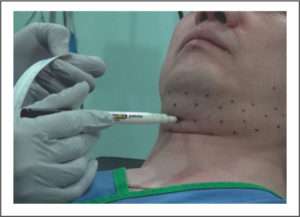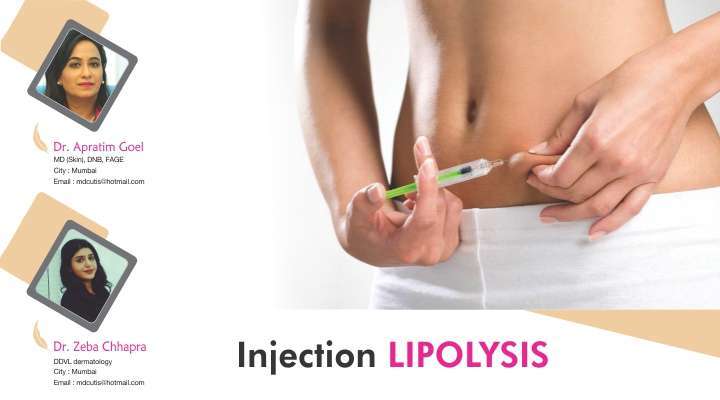What is Injection Lipolysis?
Injection lipolysis or a form of mesotherapy or mesolipolysis, is a non-invasive procedure that requires multiple fine injections of active ingredients into the treatment area beneath the skin to damage lipocytes and thus reduce fat. This can be an effective treatment to remove stubborn pockets of fat on the face, neck and body. Unlike surgery, these treatments are usually relatively simple, may be multiple sessions, usually no post operative downtime and no anaesthesia needed.
How does it work?
The theory behind lipolysis is that together the ingredients cause fat to liquefy, dissolve and be eliminated from the body. . It causes acute vacuolization of adipocytes and inflammation within the septae destroy the adipocyte cell membranes resulting in fat necrosis eventually.
Ingredients:
Various ingredients may be used including combinations of vitamins and certain medications, depending upon the particular clinical condition. The commonly used one are sodium deoxycholate and phosphatidylcholine (PPC).
1.) Deoxycholic acid ( DCA) : After FDA approval of this molecule in the US for submental fat, ths molecule has gained immense popularity in injection mesolipolysis. DCA is a bile salt that acts as a biological detergent to lyse cells. It induces fat cell destruction due to its detergent action.
2.) Phosphatidylcholine (PPC) is also a bile component, a phospholipid, emulsifier, and surfactant. PPC is the most abundant phospholipid component of cell membranes, a precursor to acetylcholine, and a constituent of lipoproteins. DC is a constituent of bile.
Patient selection –
The cosmetic application of injection lipolysis includes removal of small, stubborn, pockets of fat like double chin, love handles, tummy etc that are resistant to diet and exercise, reduction of lower eyelid pads, double chin and jowl areas, body sculpturing and defining body contours. Lipolysis is not suitable for weight loss and should be combined with a healthy lifestyle including a sensible exercise and dietary programme for best results. Medical causes must be ruled out. Factors that affect the outcome of procedure are:
1. Consistency of fat: The consistency of the fat tissue to be treated is an important factor in all cases: Is it soft fat, or does it contain a high proportion of connective tissue? Soft fat dissolves more easily than deposits containing a lot of connective tissue.
2. Size of the area to be treated – the treatment area should be small fat bulges. For larger areas and larger deposits, options like liposuction would be rather effective, unless the patients do not want to go for any surgical intervention. In such cases the patient should be informed that they will need more than the usual number of sessions. Instead of 2-3 sessions they may need 5-7 sessions or combination treatments like cryolipolysis with injection lipolysis.
3. Medical conditions :conditions : Other indications are lipomas and post liposuction irregularities.
Who cannot take injection lipolysis :
Pregnant or lactating women, diabetics with microangiopathies, inflammatory
connective tissue disorders, lipodystrophy, patients with kidney problems, severe liver conditions, blood clotting disorders, active infection.
Procedure: After careful patient selection and history taking, take written consent, photographs: frontal and side views.
Injection technique –
Injection should be given at a depth of 4-6mm on the face and 10-12mm on body. Injection can be given at an interval of 3-4 weeks. Mark the area to be treated. Each injection point should be 1.5 – 2cm apart. Maximum dose in each injection can be up to 0.5ml. maximum 50 injections.

Note :
In contrast to injections into the mesoderm, injection lipolysis treatments are delivered into the subcutaneous fat. In both cases, the depth of injection is critical to prevent damage to
In contrast to injections into the mesoderm, injection lipolysis treatments are delivered into the subcutaneous fat. In both cases, the depth of injection is critical to prevent damage to fascia. It has been hypothesized that treatment with PPC and DC reduces subcutaneous fat by adipocyte necrosis due to direct toxic or surfactant effects. Injections that are too superficial (into the dermis) may result in skin ulceration.
– Do not withdraw the needle from the subcutaneous fat during injection as this could increase the risk of intradermal exposure and skin ulceration.
– If resistance is met as the needle is inserted, indicating contact with facial or nonfat tissue avoid injecting into other tissues such as the skin, muscle, salivary glands and lymph nodes Treatments consist of multiple treatments (usually 2 or 4) approximately 4 to 6 weeks apart. Following each treatment localised swelling, redness and a light burning sensation is expected and usually lasts 12 to 24 hours. Sometimes swelling or nodule formation can happen which can last for few more weeks ( panniculitis)
Post care management –
– Use of ice/cold packs for reducing swelling, heat sensation and pain. It makes patients feel comfortable.
– Give anti-inflammatory drugs for 3 days
– We often combine injection lipolysis with HIFU ( high intensity focused ultrasound) or cryopilolysis in same session.
– Many patients see a result after the first or second treatment, although for optimal results extra treatments may be required.
Conclusion:
Injection lipolysis is a very effective tool for dermatologists and aesthetic practitioners to offer something non invasive and effective to patients seeking for stubborn fat lysis. Though The US FDA approved product Kybella is not yet available in India, Fatx and few other products (similar composition) must be tried by dermatologists for aesthetic and even medical indications. With more studies on lipolysis with deoxycholic acid alone or in combination with phosphatidylcholine we can bring about more refinement in the standard protocol and use of combination treatments like cryolipolysis and ultrasound.






